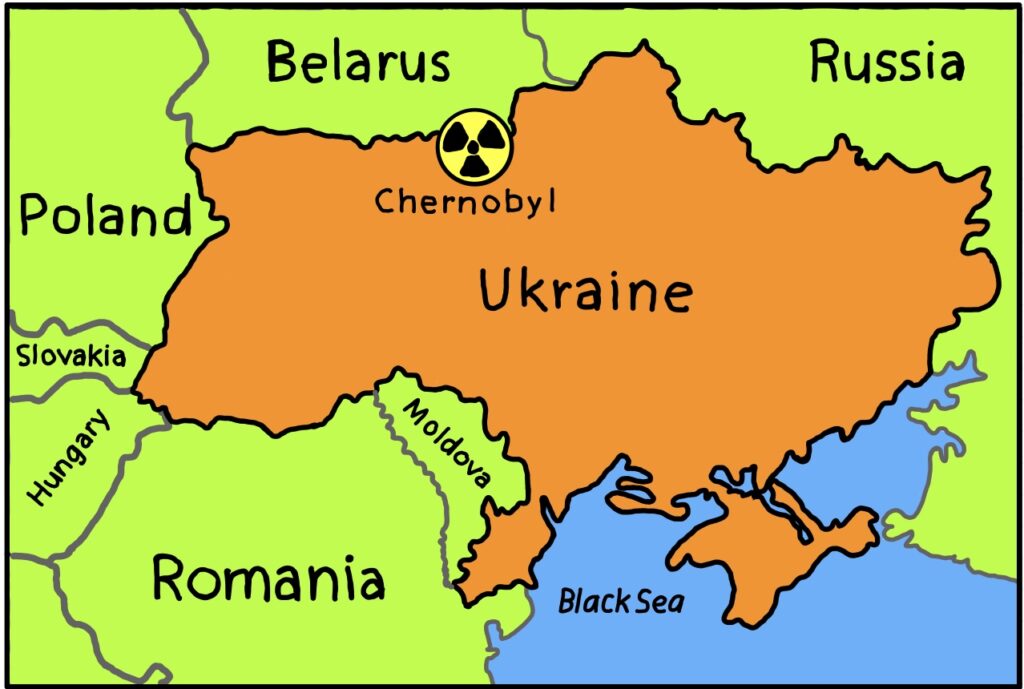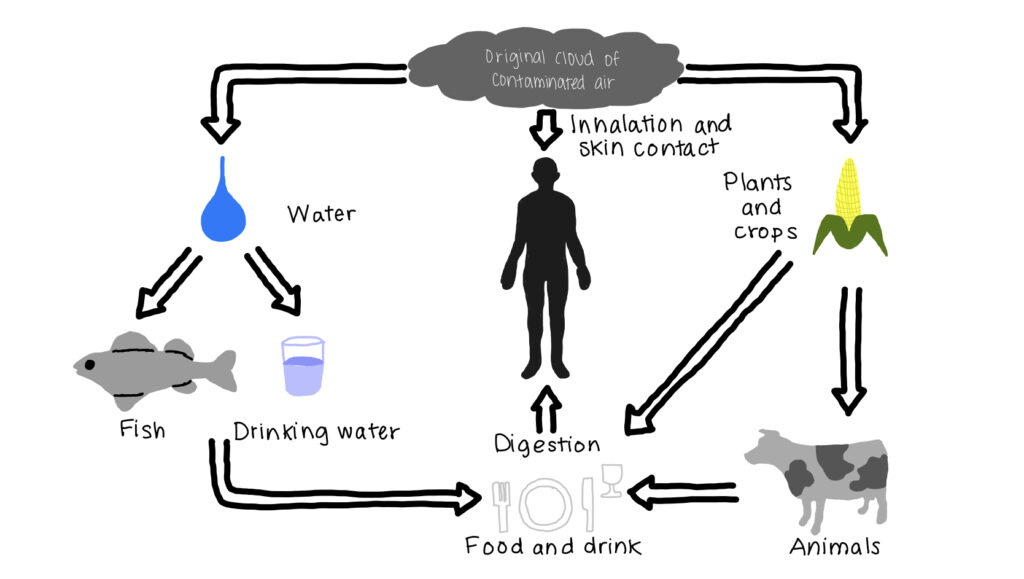Introduction
One of the worst industrial accidents that involved large doses of gamma radiation occurred on April 26th, 1986. Chernobyl’s nuclear power plant station is located near the abandoned city of Pripyat in northern Ukraine. After a failed study experiment, Chernobyl’s reactor IV exploded releasing vast amounts of radioactive material into the environment, such as several Iodine, Cesium and Strontium isotopes. It was reported that over a 20-year period the average radiation dose for those within the ‘strict radiation control’ areas received 31 millisievert (mSv) and an average of 9 mSv for the surrounding population (WNA 2022). This resulted in several public areas polluted with radioactives, this contaminated locally-grown food, water and air (Bonte 1988). The most affected were the children and onsite workers near the site of the explosion (AKYÜZ 2021). As a result, there were several reported cases of health effects which include but not limited to cancer, cognitive impairments and suicide (Omar-Nazir et al 2018). In addition, agriculture was also heavily affected as a result of black nuclear rain, radionuclides specifically Strontium-90 and Cesium-137. These were found present in the soil, farming crops and raising livestock thus, affecting the nearby population and animals (Labunska et al. 2021). This led the public and the environment to be seriously threatened after the catastrophic event. The release of radioactive chemicals highly contaminated the environment resulting in environmental injustices. This includes having contaminated air, drinking water supplies and soils, therefore affecting the lives of many people and many businesses (AKYÜZ, 2021).
 Figure 1. Map of the Chernobyl incident 1986, drawn by Fernanda Torres (adapted from Dreamstime 2022, creative commons)
Figure 1. Map of the Chernobyl incident 1986, drawn by Fernanda Torres (adapted from Dreamstime 2022, creative commons)
Effects on Agriculture
About 52,000 square kilometers of agricultural land was covered in radionuclides from the Chernobyl Disaster. Between 60 and 95% of this soil was found to have cesium-137 strongly bound to soil components. During 1991, cesium-137 activity concentration within the 0-5 cm soil layer ranged from 25-1,000 kBq/m3 (NEA 2002). This would have dire consequences as agricultural crops would uptake these radionuclides through their roots. Uptake of these radionuclides are then consumed by crops and have very high rates to be transferred to animal products (Agricultural & Environmental Impacts 2022). However, this wouldn’t have been an issue had countermeasures designed to prevent human exposure were imposed immediately after the accident. Sadly, these countermeasures were not introduced immediately and cesium-137 would be exposed to crops, cattle, and eventually to humans. Due to these actions, cesium-137, with a half-life of just over 30 years, would remain detectable in agricultural lands for another 10 half lives, or another 300 years (NEA 2002).
Direct Human Consumption
Since the cattle were exposed to cesium-137 this may render the animal as unfit for a source of meat, milk, and eggs (Hood and Comar 2022). The concentration of cesium-137 was measured using rats and two cows for 30-60 days. The results found that with the prolonged exposure of cesium-137, internal exposure through ingestion or inhalation does allow the radioactive material to be spread in the muscle tissue, bone and plasma. Muscle had the highest concentration, with bone and plasma having the lowest (Hood and Comar 2022). Cesium-137 can cause burns, acute radiation, sickness and death. Due to high-energy gamma radiation it can increase the risk of cancer (EPA 2022).

Figure 2. Main pathways of radiation into humans drawn by Fernanda Torres (adapted from BBC News 2022).
Health Risks
The Chernobyl accident was recorded as the largest uncontrolled radioactive release in history. Onsite workers and the surrounding public were exposed to the following radionuclides: Iodine-131, cesium-134 and cesium-137 (Drozdovitch 2020). The following consequences that followed were high record cases of thyroid cancer (Drozdovicth 2020). This was primarily due to iodine-131, with a short half life of eight days, as this radionuclide is capable of being taken up by the thyroid gland and is reported with higher doses in children than in adults due to children having smaller thyroid mass (Cardis & Hatch 2011). In fact 20,000 cases of thyroid cancer were reported among exposed children and adolescents, first in Belarus followed by Ukraine and Russia. Primarily due to ingestion of these radionuclides via food and water (Cardis & Hatch 2011). In addition, 134 of the 600 workers suffered from acute radiation sickness and those that were exposed to high doses of radiation reported cases of leukemia and cataracts. As a whole, the surrounding public suffered a general exposure, averaging an effective radiation dose of 30mSv (Hatch et al 2005).

Figure 3. Representation of Thyroid Cancer, drawn by Fernanda Torres (adapted from CancerNetwork 2019, creative commons).
Takeaway/Environmental Injustices
An environmental injustice issue raised by the Chernobyl disaster is distributive injustice, where equal distribution of environmental goods is not consistent with the communities being affected (AKYÜZ, 2021). It was demonstrated that the population surrounding the area, just around 30 km from the disaster site called the CEZ, was the most affected, both physically, socially and environmentally (IAEA 2006).
Since the Chernobyl incident there has been a cancer registry founded in Belaus. The examination found there has been an increase in thyroid cancer detected in children living in the areas of Belarus, Ukraine and Russia (Drozdovitch 2020). Results of most of the epidemiological studies conducted so far must be considered provisional in any case, as the complete analysis of the health effects of the accident is an ongoing process. Many sources agree that the immune defenses have been lowered in children and young people living in the lands affected by the nuclear fall-out (Drozdovitch 2020). Their quality of life decreased and many found themselves in poverty and had to find a way to cope with the catastrophe, others, more brave, had the courage to return to the abandoned area where they used to live (IAEA 2006). The activities undertaken by Belarus and Ukraine following the accident (environmental remediation, evacuations and resettlement, development of non-contaminated food sources, public health measures) weighed heavily on the governments of these countries. International agencies and foreign governments have provided logistical and humanitarian assistance. Moreover, thanks to the efforts of the European Commission and the WHO to strengthen epidemiological research structures in Russia, Ukraine and Belarus, these states were able to carry out autonomous epidemiological studies (IAEA 2006). Therefore, distributive injustice seems an issue for unequal distribution of environmental harms in Chernobyl.
References
AKYUZ E. Environmental Justice and Nuclear Accidents: The Case of Chernobyl Disaster. International Journal of Environment and Geoinformatics . 2021 Sep [accessed 2022 Oct 31]. https://dergipark.org.tr/en/download/article-file/1535874
Alan N. Peiris MD. Monitoring for thyroid cancer recurrence. Cancer Network. [accessed 2022 Nov 13]. https://www.cancernetwork.com/view/monitoring-thyroid-cancer-recurrence
Cardis E, Hatch M. The Chernobyl accident – an epidemiological perspective. Clinical Oncology. 2011 Mar 10 [accessed 2022 Oct 31]. https://www.sciencedirect.com/science/article/abs/pii/S0936655511005425
Chernobyl disaster’s agricultural and environmental impact. Chernobyl Disaster’s Agricultural and Environmental Impact: Part two of a series (EnvironmentalChemistry.com). [accessed 2022 Oct 31]. https://environmentalchemistry.com/yogi/hazmat/articles/chernobyl2.html
Chernobyl stock illustrations – 1,199 Chernobyl stock illustrations, Vectors & Clipart. Dreamstime. [accessed 2022 Nov 13]. https://www.dreamstime.com/illustration/chernobyl.html
Chernobyl: Assessment of Radiological and Health Impacts. EPA. [accessed 2022 Oct 31]. https://www.epa.gov/radiation/radionuclide-basics-cesium-137
Chernobyl: Chapter VI. Agricultural and Environmental Impacts. Nuclear Energy Agency (NEA). [accessed 2022 Oct 31]. https://www.oecd-nea.org/jcms/pl_28351/chernobyl-chapter-vi-agricultural-and-environmental-impacts
Drozdovitch V. Radiation exposure to the thyroid after the Chernobyl accident. Frontiers in endocrinology. 2021 Jan 5 [accessed 2022 Oct 31]. https://www.ncbi.nlm.nih.gov/pmc/articles/PMC7813882/
FJ; B. Chernobyl retrospective. Seminars in nuclear medicine. 1988 Jan 18 [accessed 2022 Oct 31]. https://pubmed.ncbi.nlm.nih.gov/3278382/
Hatch M, Ron E, Bouville A, Zablotska L, Howe G. Chernobyl disaster: Cancer following the accident at the Chernobyl Nuclear Power Plant. OUP Academic. 2005 Jul 1 [accessed 2022 Oct 31]. https://academic.oup.com/epirev/article/27/1/56/520833?login=false
Hood SL, Comar CL. Metabolism of cesium-137 in rats and farm animals. Archives of Biochemistry and Biophysics. 2005 Aug 17 [accessed 2022 Oct 31]. https://www.sciencedirect.com/science/article/abs/pii/S0003986153800184
IAEA. Environmental Consequences of the Chernobyl Accident and their Remediation: Twenty Years of Experience. 2006 [ accessed 2022 Nov 14] https://www-pub.iaea.org/MTCD/publications/PDF/Pub1239_web.pdf.
In depth | chernobyl. BBC News. 2005 Jun 20 [accessed 2022 Oct 31]. http://news.bbc.co.uk/1/shared/spl/hi/guides/456900/456957/html/nn4page1.stm
Labunska I, Kashparov V, Levchuk S, Santillo D, Johnston P, Polishchuk S, Lazarev N, Khomutinin Y. Current radiological situation in areas of Ukraine contaminated by the Chernobyl accident: Part 1. human dietary exposure to caesium-137 and possible mitigation measures. Environment International. 2018 May 26 [accessed 2022 Oct 31]. https://www.sciencedirect.com/science/article/pii/S0160412017321542?fr=RR-2&ref=pdf_download&rr=7631c1f6ea15c525
Omar-Nazir L;Shi X;Moller A;Mousseau T;Byun S;Hancock S;Seymour C;Mothersill C; Long-term effects of ionizing radiation after the Chernobyl accident: Possible contribution of Historic Dose. Environmental research. 2018 Aug 16 [accessed 2022 Oct 31]. https://pubmed.ncbi.nlm.nih.gov/29665465/
Radionuclide Basics: Cesium-137. EPA. 2022 Jul 5 [accessed 2022 Oct 31]. https://www.epa.gov/radiation/radionuclide-basics-cesium-137
“25 Anni Dal Disastro Di Chernobyl.” OLTRE IL MURO: ARTE e FOTOGRAFIA, http://no-miedo.blogspot.com/2011/04/25-anni-dal-disastro-di-chernobyl.html
AKYUZ E. Environmental Justice and Nuclear Accidents: The Case of Chernobyl Disaster. International Journal of Environment and Geoinformatics . 2021 Sep [accessed 2022 Oct 31]. https://dergipark.org.tr/en/download/article-file/1535874 Alan N. Peiris MD. Monitoring for thyroid cancer recurrence. Cancer Network. [accessed 2022 Nov 13]. https://www.cancernetwork.com/view/monitoring-thyroid-cancer-recurrence Cardis E, Hatch M. The Chernobyl accident - an epidemiological perspective. Clinical Oncology. 2011 Mar 10 [accessed 2022 Oct 31]. https://www.sciencedirect.com/science/article/abs/pii/S0936655511005425 Chernobyl disaster's agricultural and environmental impact. Chernobyl Disaster's Agricultural and Environmental Impact: Part two of a series (EnvironmentalChemistry.com). [accessed 2022 Oct 31]. https://environmentalchemistry.com/yogi/hazmat/articles/chernobyl2.html Chernobyl stock illustrations – 1,199 Chernobyl stock illustrations, Vectors & Clipart. Dreamstime. [accessed 2022 Nov 13]. https://www.dreamstime.com/illustration/chernobyl.html Chernobyl: Assessment of Radiological and Health Impacts. EPA. [accessed 2022 Oct 31]. https://www.epa.gov/radiation/radionuclide-basics-cesium-137 Chernobyl: Chapter VI. Agricultural and Environmental Impacts. Nuclear Energy Agency (NEA). [accessed 2022 Oct 31]. https://www.oecd-nea.org/jcms/pl_28351/chernobyl-chapter-vi-agricultural-and-environmental-impacts Drozdovitch V. Radiation exposure to the thyroid after the Chernobyl accident. Frontiers in endocrinology. 2021 Jan 5 [accessed 2022 Oct 31]. https://www.ncbi.nlm.nih.gov/pmc/articles/PMC7813882/ FJ; B. Chernobyl retrospective. Seminars in nuclear medicine. 1988 Jan 18 [accessed 2022 Oct 31]. https://pubmed.ncbi.nlm.nih.gov/3278382/ Hatch M, Ron E, Bouville A, Zablotska L, Howe G. Chernobyl disaster: Cancer following the accident at the Chernobyl Nuclear Power Plant. OUP Academic. 2005 Jul 1 [accessed 2022 Oct 31]. https://academic.oup.com/epirev/article/27/1/56/520833?login=false Hood SL, Comar CL. Metabolism of cesium-137 in rats and farm animals. Archives of Biochemistry and Biophysics. 2005 Aug 17 [accessed 2022 Oct 31]. https://www.sciencedirect.com/science/article/abs/pii/S0003986153800184 IAEA. Environmental Consequences of the Chernobyl Accident and their Remediation: Twenty Years of Experience. 2006 [ accessed 2022 Nov 14] https://www-pub.iaea.org/MTCD/publications/PDF/Pub1239_web.pdf. In depth | chernobyl. BBC News. 2005 Jun 20 [accessed 2022 Oct 31]. http://news.bbc.co.uk/1/shared/spl/hi/guides/456900/456957/html/nn4page1.stm Labunska I, Kashparov V, Levchuk S, Santillo D, Johnston P, Polishchuk S, Lazarev N, Khomutinin Y. Current radiological situation in areas of Ukraine contaminated by the Chernobyl accident: Part 1. human dietary exposure to caesium-137 and possible mitigation measures. Environment International. 2018 May 26 [accessed 2022 Oct 31]. https://www.sciencedirect.com/science/article/pii/S0160412017321542?fr=RR-2&ref=pdf_download&rr=7631c1f6ea15c525 Omar-Nazir L;Shi X;Moller A;Mousseau T;Byun S;Hancock S;Seymour C;Mothersill C; Long-term effects of ionizing radiation after the Chernobyl accident: Possible contribution of Historic Dose. Environmental research. 2018 Aug 16 [accessed 2022 Oct 31]. https://pubmed.ncbi.nlm.nih.gov/29665465/ Radionuclide Basics: Cesium-137. EPA. 2022 Jul 5 [accessed 2022 Oct 31]. https://www.epa.gov/radiation/radionuclide-basics-cesium-137 “25 Anni Dal Disastro Di Chernobyl.” OLTRE IL MURO: ARTE e FOTOGRAFIA, http://no-miedo.blogspot.com/2011/04/25-anni-dal-disastro-di-chernobyl.html.

Provide Feedback